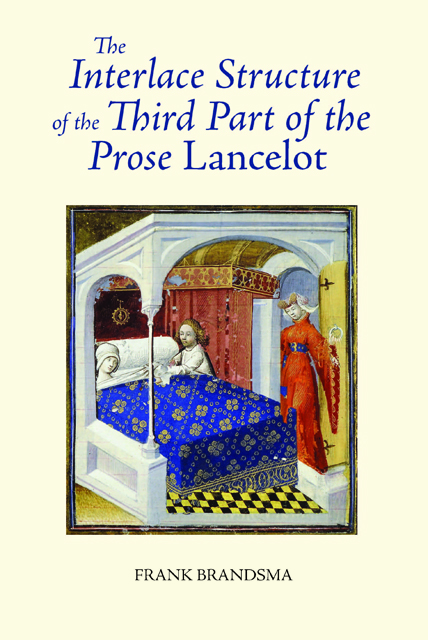Book contents
- Frontmatter
- Contents
- Dedication
- Preface
- Editorial Conventions
- List of Abbreviations
- Plot Summary of the Prose Lancelot and Vulgate Cycle
- 1 Introduction
- 2 Interlace: The Narrative Technique in Lancelot Part 3
- 3 Interlace: The Themes of Lancelot Part 3
- 4 Conclusion: Narration (Revisited) and the Audience
- Appendix 1 Survey of Prose Lancelot Manuscript According to (1) Date and (2) Contents
- Appendix 2 The Interlace of the Primary Narrative Threads in Lancelot Part 3
- Appendix 3 Reading Time
- Bibliography
- Index
Appendix 1 - Survey of Prose Lancelot Manuscript According to (1) Date and (2) Contents
Published online by Cambridge University Press: 18 February 2023
- Frontmatter
- Contents
- Dedication
- Preface
- Editorial Conventions
- List of Abbreviations
- Plot Summary of the Prose Lancelot and Vulgate Cycle
- 1 Introduction
- 2 Interlace: The Narrative Technique in Lancelot Part 3
- 3 Interlace: The Themes of Lancelot Part 3
- 4 Conclusion: Narration (Revisited) and the Audience
- Appendix 1 Survey of Prose Lancelot Manuscript According to (1) Date and (2) Contents
- Appendix 2 The Interlace of the Primary Narrative Threads in Lancelot Part 3
- Appendix 3 Reading Time
- Bibliography
- Index
Summary
Diagram 1 gives a chronological survey of the manuscripts containing the Prose Lancelot (or parts of this text) or Lancelot propre, with the exception of the smaller fragments. The diagram is based on Micha's articles and the, rather rough, dates he provides and on Elspeth Kennedy's introduction to her edition. The material has been compared with the lists Woledge provides. The diagram shows all the manuscripts containing a Lancelot that Woledge lists, except for Turin *1688 (L-V-30) and Darmstadt 2534, since I was unable to ascertain the exact contents of these manuscripts.
Giving a date for the manuscripts is hazardous, anyway. Micha's dates are often far from specific and sometimes wrong. When additional information with regard to the date of a given manuscripts was available, Micha's date has been replaced by a date in italics, giving usually a more specific date (and sometimes location). Further research may provide new dates for other manuscripts as well and thus new positions for those manuscripts in this chronological survey. It seems unlikely that these corrections will dramatically change the general pattern, as described and used in Chapter 1.
On top, in bold the diagram gives the usual components of the cycle, with the central Lancelot divided, as in Micha's description, into three parts corresponding to the three volumes of Sommer's edition. By means of the little blocks, the diagram shows what each manuscript contains; three blocks means: all of the text corresponding to that Sommer volume is found in this manuscript. The numbers before or after a set of blocks refer to the page in Sommer's edition where a manuscript begins or breaks off. The prose Charrette is represented by a diamond. It divides the cyclic Lancelot into two roughly equal parts.
Manuscripts that have an asterisk on the far right of the diagram have been checked in manuscript or microfilm. Notes regarding the manuscripts are given separately after diagram 2. BL stands for British Library (London), BN for Bibliothèque Nationale (Paris); for A’dam+Ryl, see the remarks on p. 236.
Diagram 2 follows the format of diagram 1. The sequence here, however, is based on what the manuscripts contain. If two or more manuscripts have exactly the same components they are given in chronological order.
- Type
- Chapter
- Information
- The Interlace Structure of the Third Part of the Prose Lancelot , pp. 228 - 238Publisher: Boydell & BrewerPrint publication year: 2010



